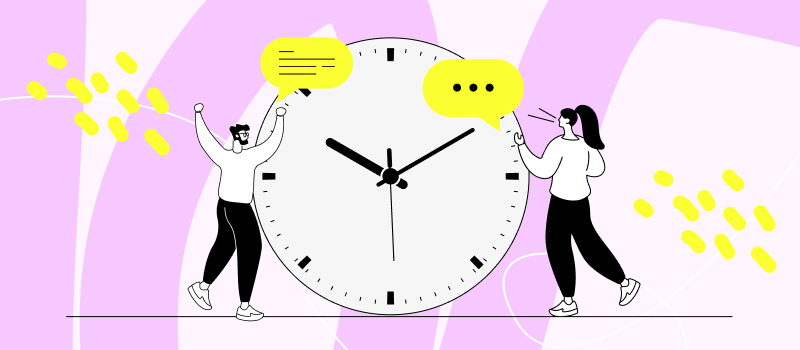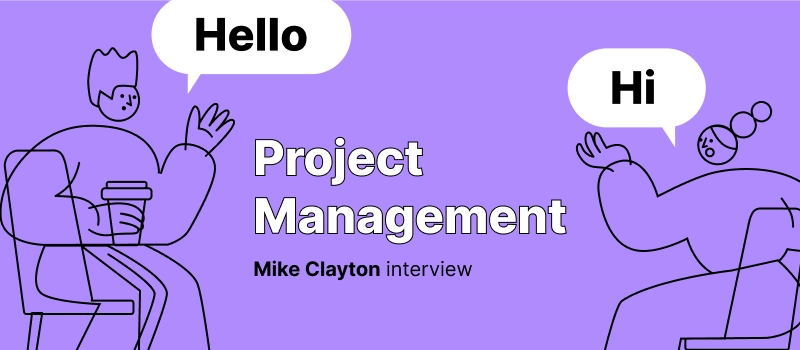
When managing a project, you want to find an efficient method to drive your team to success. With the right project outline model, you can schedule your project deliverables and develop a structure that your team can follow throughout the process.
You’ll need to establish a project model that makes sense. You will want to outline your scheduling and all the factors and members involved in one model that follows a clear path to your outcome.
With all elements defined and tasks assigned to your team, they need the discipline of deadlines and timeframes within which they need to be productive and complete their work. You will want your team to be accountable so they can effectively contribute a fair, balanced amount of effort to your complete project.
So which project model offers the best structure to guide you and your project team to complete a high-grade product that will satisfy your clients?
What Is Waterfall Model?
The waterfall method is a way of organizing your project activities in a gradual, cascade-like manner.
By sectioning one large project into several scheduled phases with associated tasks, your project will be much more achievable and easier to complete on time.
When using it, you just need to consider your work process as a whole and divide it into several consecutive, logically connected phases, so that the end result of a preceding phase provides an input for the next one.
Let’s explore the original version of the waterfall model by Dr. Winston W. Royce:
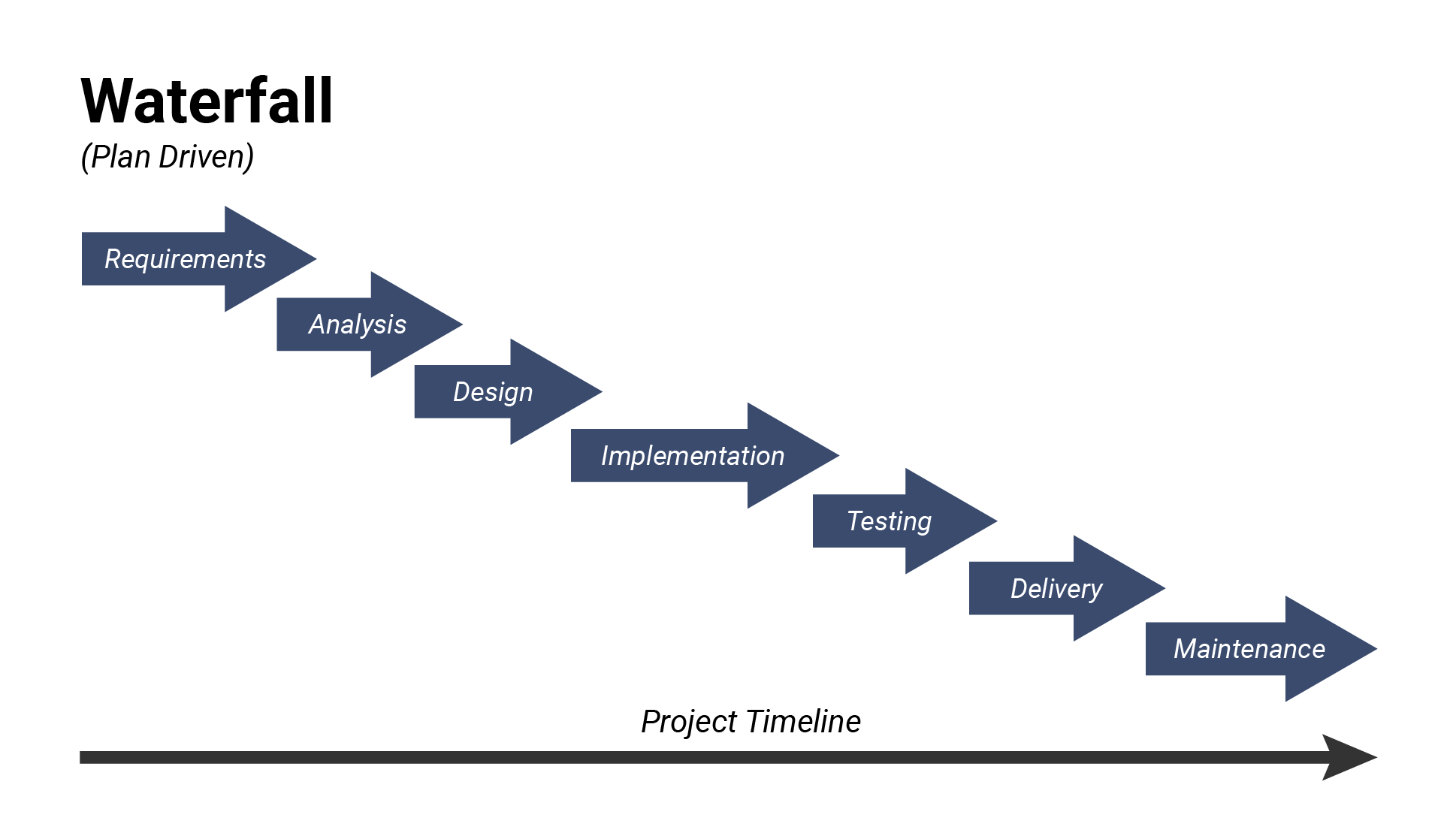
Each of the above phases produces an output that contributes essential information and materials to the consecutive phase.
That way, all deliverables are met with enough attention to detail that no major errors are made that impact your project’s overall quality.
When implementing the waterfall model, you will develop a schedule or roadmap that will stay in place throughout your project. Contrary to its name, this is not a fluid model that you will want to adapt or reshape while work is being done to meet the collective end goal. Instead, the waterfall model’s outline will be strict to avoid lags in production, adding to a very long delivery delay and an upset client.
Waterfall Model Vs Linear Model
The Linear model, also known as the Sequential model, shares similarities with the Waterfall model in terms of its sequential nature.
It also involves distinct stages that are completed in a linear fashion, similar to the Waterfall model and emphasizes comprehensive documentation at each stage, similar to the Waterfall model.
However, the Linear model focuses on completing specific tasks in a linear order without revisiting previous stages once they are completed.
Modified Waterfall Model
The Modified Waterfall model was described by Steve McConnell in 1996. The modified Waterfall model consists of the same phases as the classic model but allows for phases to overlap and break the project down into subprojects. The modified Waterfall model was created in response to the drawbacks of the classic Waterfall model.
Waterfall Model: Advantages and Disadvantages
Advantages of the Waterfall Model
- Easy and straightforward. Each Waterfall phase has its own review process and deliverables.
- Predictable. All the requirements, processes, timelines, deadlines and end-product are fixed and well-documented.
- Comprehensive documentation. Waterfall requires many project management deliverables, which ensure a greater understanding of the tasks and the end product.
- The fastest project delivery in small and simple projects.
Disadvantages of the Waterfall Model
- No room for changes. Waterfall is not compatible with changes in client requirements
- Never backward. Waterfall is a traditional project management methodology that doesn’t allow teams to get back to the previous project development phases
- Delayed testing. In the Waterfall model, testing is delayed until the end of the project development, meaning you discover mistakes and flaws too late and have to invest a lot of time in fixing them instead of managing them early on.
- Reduced efficiency because project phases don’t overlap.
- Pressure and stress caused by inflexible deadlines.
- Lower customer satisfaction due to the lack of customer feedback during the implementation phase.
- High risks. If any unexpected obstacles happen, there’s a high chance that they will negatively impact your project’s timeline.
- Not suitable for complex projects with high risks.
When to Use The Waterfall Model
The waterfall model is most commonly used in software engineering and product development, less often – in other projects and industries.
Employ the waterfall model only if your project meets the following criteria:
- All the requirements are known, clear, and fixed
- There are no ambiguous requirements
- The project is short and simple
- The development environment is stable
- Resources are adequately trained and available
- The necessary tools and techniques used are stable, and not dynamic
If your project doesn’t fit this description, consider one of the following most common waterfall model alternatives:
- for software projects: joint application development (JAD), rapid application development (RAD), sync-and-stabilize, Agile project management, the Spiral Model.
- for other projects: Agile project management, Scrum, Kanban.
Phases of the Waterfall Model
The waterfall model entails breaking your project into several phases that must be completed consecutively. Imagine flowing water in a waterfall. Your project will begin at the top and descend the waterfall into the stream at the bottom. This happens in one, smooth flowing pattern, rather than a scattered, horizontal stream.
Each of your waterfall model phases will precede the next until you approach your final project deadline.
1. Requirement Collection and Documentation
One of the key features of the Waterfall model is that all customer requirements are collected and approved before the beginning of the project, meaning no mid-project changes are allowed. The outcome of this phase is a project requirements document, which means that all necessary data is collected and no further customer interference is required
2. Project Analysis
Project specifications are reviewed from business perspectives, technical and financial resources are audited for feasibility.
3. System Design
Project manager relies on project requirements to develop project specifications, including project plan.
4. Implementation
At this stage, all the previous planning is put into action.
5. Testing
After the development is completed, testing is performed to identify flaws and errors, fix and polish the end-product. Customer involvement is possible.
6. Delivery
The fully functional product is released or handed over to the customer. In non-software projects, delivery is most often the final phase.
7. Maintenance (optional)
Software projects often require maintenance, such as product improvements and updates.
All these stages flow downwards one-by-one like a waterfall. The next stage is started only after the previous one is over.
Following the process cycle suggested in the original waterfall model and completing each phase step by step, you’re bound to produce a properly functioning, high-quality piece of software.
However, even if you operate in another industry and have nothing to do with software development, you may still implement the waterfall method, simply adjusting the listed steps to your specific needs.
For instance, the phases in the process of content marketing may include:
- Keyword research
- Plan development
- Content writing
- Design
- Editing
- Release
Within this work order, the outcomes of keyword research will serve as an input for plan development, while a content plan created at the second phase will provide the basis for content writing. And so on.
Just a brief look at your current (or desired) work plan will help you identify the phases to include in the waterfall model and understand which outputs they must result in.
Real-Life Waterfall Model Example
To help you get a better understanding of the Waterfall model, here's a real-life example of a software project. See how every phase follows the previous one until the project reaches its delivery point.
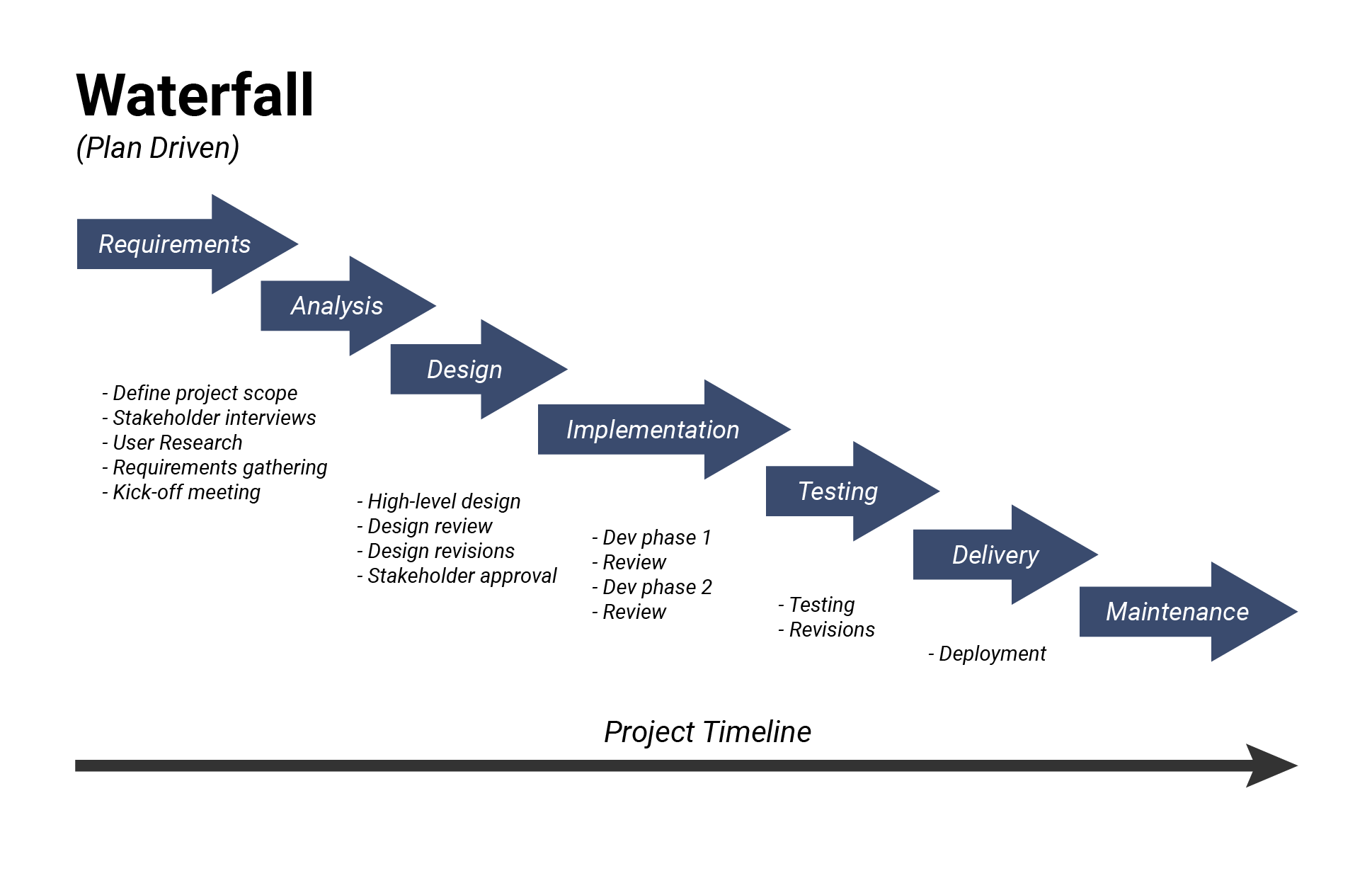
Implementing the Waterfall Model
To develop your waterfall model, you will need to have all the necessary information for your project. This includes:
- All employees committed to the project and their designated roles
- All materials (internal and external) required
- Phase scheduling
- Task deadlines
- Project scope
- Project budget
- Client involvement
You can format this information in one document or chart that will be easy for your team members to refer to as the project is on its way to completion. With the details and outline of their project available, they can understand what’s expected of them and the impact of their completed duties on the project’s completion and scheduling.
Want to know how strong your project time management skills are? Pass our quiz to find out!
Waterfall Model and Agile
Arguably the more common model of the two, the agile process describes an alternative method that relies on the product, its people, and communications. Agile development is much more flexible in nature compared to the waterfall model. It combines a variety of tools to create a more efficient software development process.
At its core, the work completed in an agile process still closely resembles the waterfall model. The model still requires designs, requirements, development, and the integration of other products. Finally, the product is tested and modified according to the testing results until it is ready to use. The main difference between the two models is that the agile model uses an empirical control method, which means there is more focus on evaluating and continuing based on the current observations. Rather than moving through clear-cut stages, the agile process adapts depending on the actual project’s status.
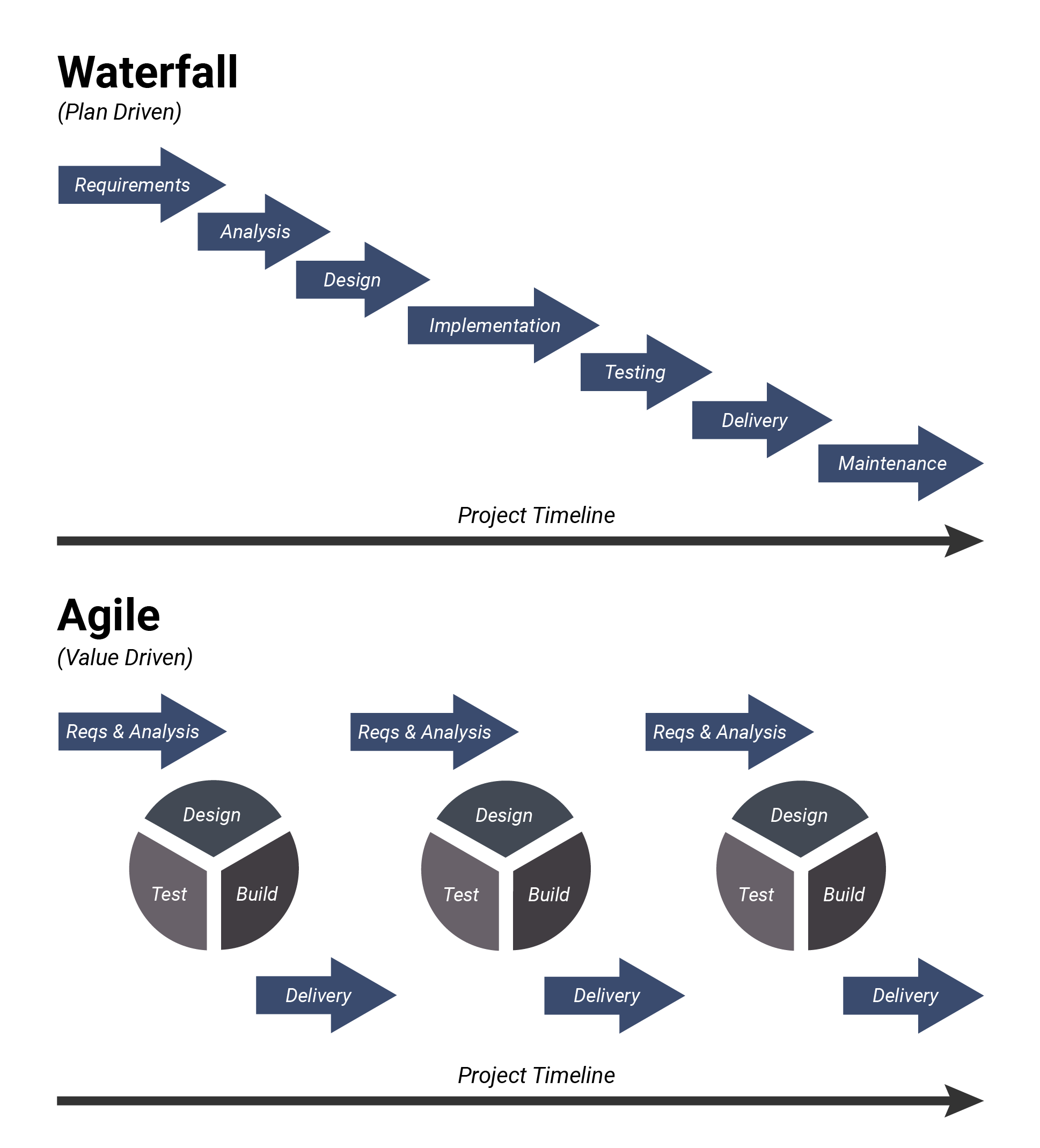
Advantages of Agile
- Superior quality product and higher customer satisfaction due to client involvement in the development process.
- Increased flexibility. Agile divides projects into small sprints that allow teams to implement changes on short notice.
- Reduced risks. Agile works in small sprints that focus on continuous delivery and eliminate chances of project failure.
- Continuous improvement. The cyclic structure and customer feedback allow project teams to improve the product throughout its development process.
- Improved team morale. Another distinct feature of Agile teams is self-organization, meaning more autonomy, less micromanagement and stress.
- Improved performance visibility with daily meetings and project progress charts.
Disadvantages of Agile
- Poor resource planning. Agile projects are not limited by the end result - they are continuously improved, meaning low control over project resources.
- Difficult to evaluate project time and costs. Agile projects welcome customer feedback and changes to the project requirements that usually bloat project timelines and costs.
- High possibility of scope creep. Projects easily get sidetracked due to high customer involvement and their changes to the project requirements.
- Limited documentation. In Agile projects, documentation is built incrementally, meaning it is not detailed enough to be reliable.
Ready to Improve Your Waterfall Project Management?
Waterfall model is rather simple and straightforward but we recommend having a reliable piece of software in place to make sure that you have enough resources to meet time and quality standards and other customer requirements.
For example, actiTIME features that allow users to adhere to the waterfall method with higher efficiency are the Kanban board and customizable workflow statuses.
The main purpose of the Kanban board is to visualize task progress. The board itself is divided into several columns that represent the varying phases in the work process (e.g., planning, in-progress, completed, etc.).
By moving their tasks across the different sections of the board on a daily basis, users get a clear idea of where they currently are in terms of project progress. Thereby, the Kanban board lets teams control their performance more effectively.
In actiTIME, it’s possible to customize workflow / task statuses. It means nothing prevents you from creating a workflow in line with your waterfall model:
- Go to Workflow Settings,
- Click on + Add new status
- Type the name of the status (a phase in the waterfall methodology)
- Choose a preferable color code to associate with it
- Press on the Apply button
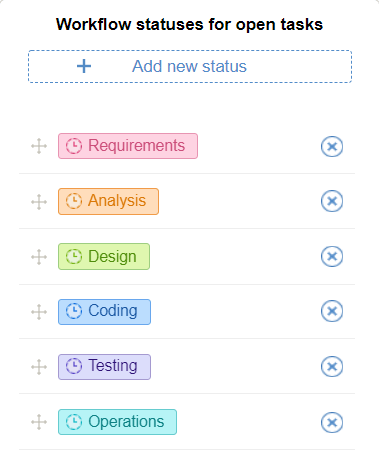
Once done, go to the Tasks interface and create a new project by clicking on + Add New and filling the necessary information in the opened window:
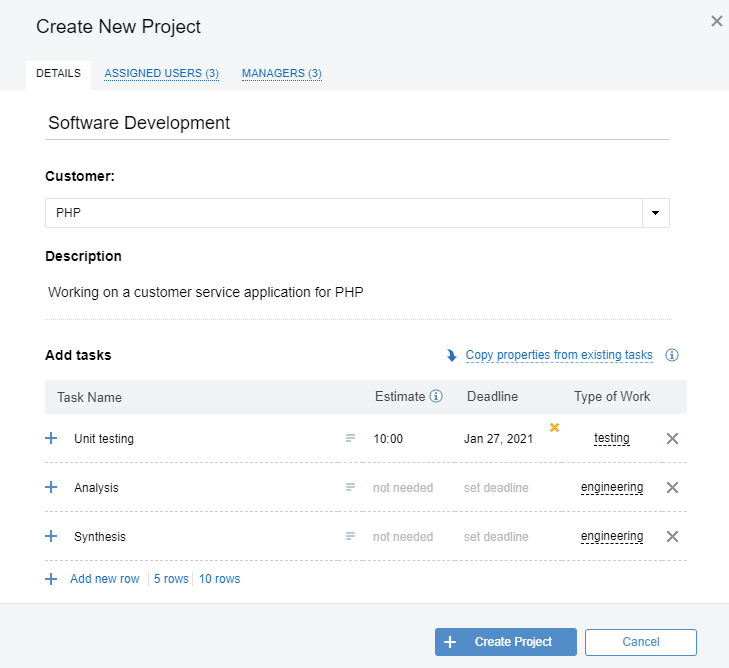
After that, you’ll be able to review the newly created project and tasks on the Kanban board:
- Locate the view mode buttons in the upper right corner of the Tasks interface and choose Kanban there
- Distribute your tasks across the appropriate sections of the board, linking each item to a relevant phase of the waterfall model
- Start working on your project phase by phase, and whenever a task is completed, drag it to the completed tasks column
- This way, you’ll see when all the tasks for a particular project phase are entirely closed, which is a sign that you can proceed to working on the next phase
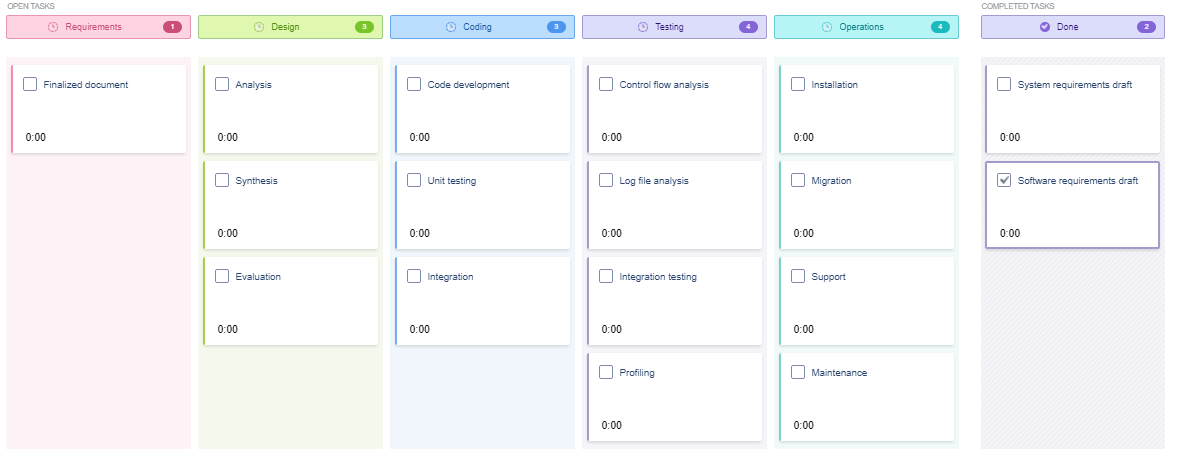
Note: To introduce greater transparency into progress tracking, consider subdividing the primary workflow statuses into smaller groups. For instance, you may create such subgroups as:
- Requirements – In-Progress
- Requirements – Under Review
- Requirements – Done
- Coding – In-Progress
- Coding – Under Review
- Coding – Done
- Design – In-Progress, etc.
This will let you monitor your progress in terms of both the completion of each process phase as a whole and every small task individually.
Besides that, in actiTIME, you can create any number of workflow statuses and custom fields for tasks.
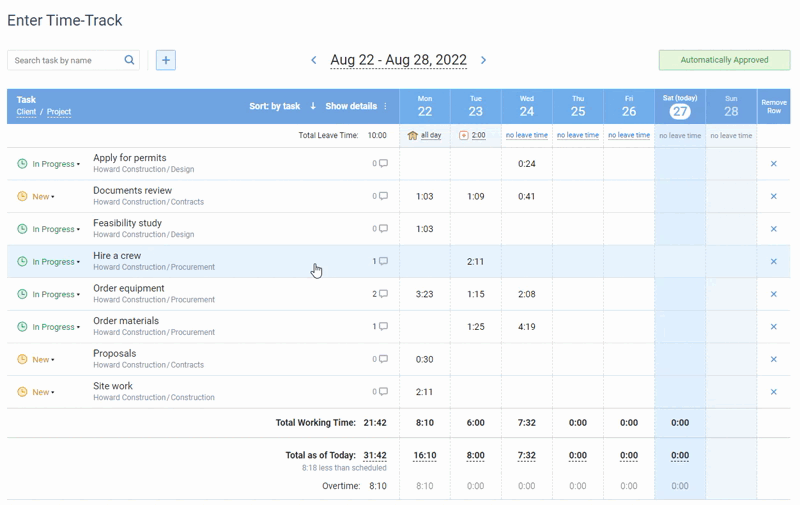
Online timesheet interface in actiTIME where every user can select task parameters
they want to see in their timesheets
Task estimates and deadlines will ensure that the deadlines are met, while analytics and reporting tools will help you stay within time and cost budgets. Explore the full functionality of actiTIME - start your free 30-day trial (no credit card required).














































